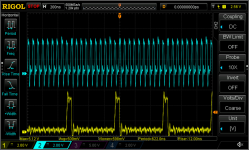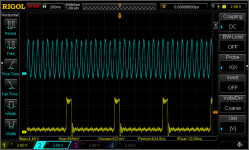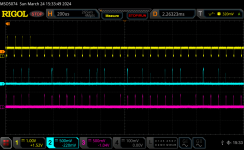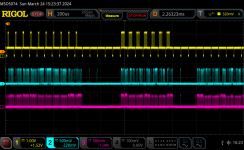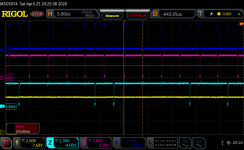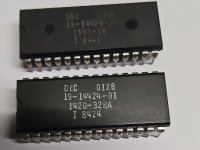I have been restoring a VT100. I have replaced one of the RAM chips and the sender UART for the keyboard and the main board seems to work, except for the video output. I think the bad video output may be affecting the video driver board, so I have removed it for now. I am using the external video connector to drive an LCD screen and a little video converter. I have tested this setup with a known working VT102 to make sure it works, the output isn't displayed quite right, with a bit of clipping, but it is recognisable.
However, when I use this setup with the VT100 all I can see is what I believe to be the cursor flashing, but for the full height of the screen. If I type characters the cursor moves across the screen but I don't see any output relating to the characters. If I press the SETUP key I just get a completely black screen. I do see something that looks like a test pattern immediately after powering on, but it is random vertical bars, whereas the VT102 displays a large block of white.
I have checked that the DMA is transferring the correct data from the screen RAM using a logic analyser and it is getting to the character generator ROM. And I can see bits coming from the character generator ROM, so even if the character generator ROM was bad I would think I would see something, even if it was garbage. The fact that something does get displayed would suggest that the DC012 is working, and I can see that its other outputs seem valid, like HOLD REQ H etc. If there was anything else between the DC012 and the actual composite output that wasn't working it would seem unlikely to manifest itself like this, although I confess I am not sure I understand the circuit between the DC012 and the actual composite output, so I could be wrong.
I wonder if anyone has any suggestions for what to look at?
Thanks
However, when I use this setup with the VT100 all I can see is what I believe to be the cursor flashing, but for the full height of the screen. If I type characters the cursor moves across the screen but I don't see any output relating to the characters. If I press the SETUP key I just get a completely black screen. I do see something that looks like a test pattern immediately after powering on, but it is random vertical bars, whereas the VT102 displays a large block of white.
I have checked that the DMA is transferring the correct data from the screen RAM using a logic analyser and it is getting to the character generator ROM. And I can see bits coming from the character generator ROM, so even if the character generator ROM was bad I would think I would see something, even if it was garbage. The fact that something does get displayed would suggest that the DC012 is working, and I can see that its other outputs seem valid, like HOLD REQ H etc. If there was anything else between the DC012 and the actual composite output that wasn't working it would seem unlikely to manifest itself like this, although I confess I am not sure I understand the circuit between the DC012 and the actual composite output, so I could be wrong.
I wonder if anyone has any suggestions for what to look at?
Thanks

